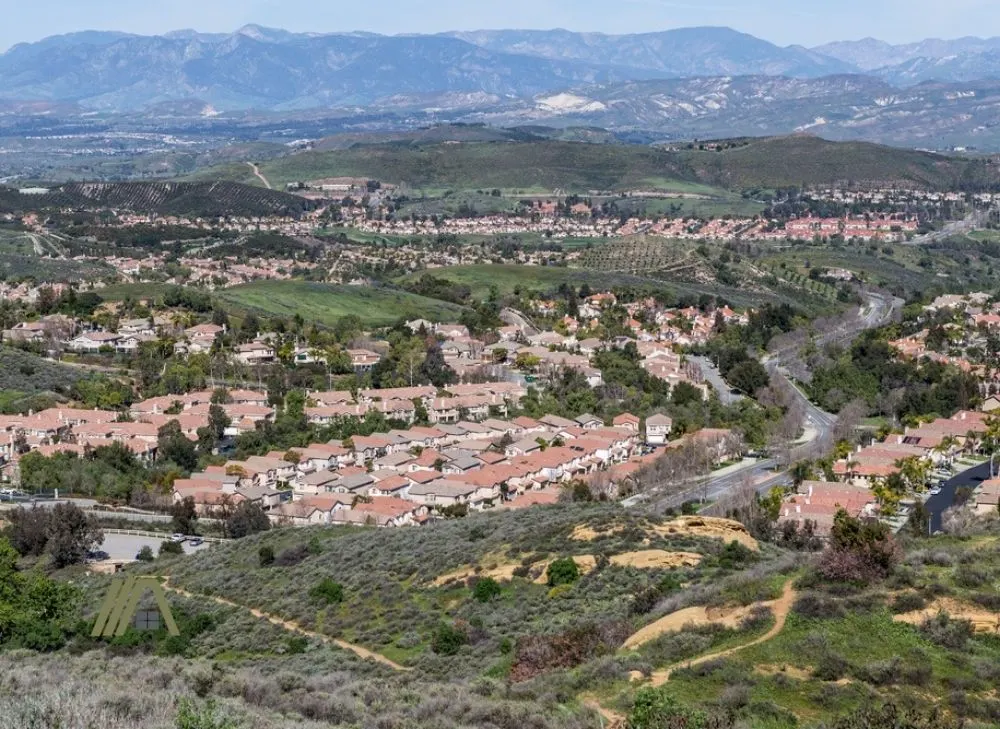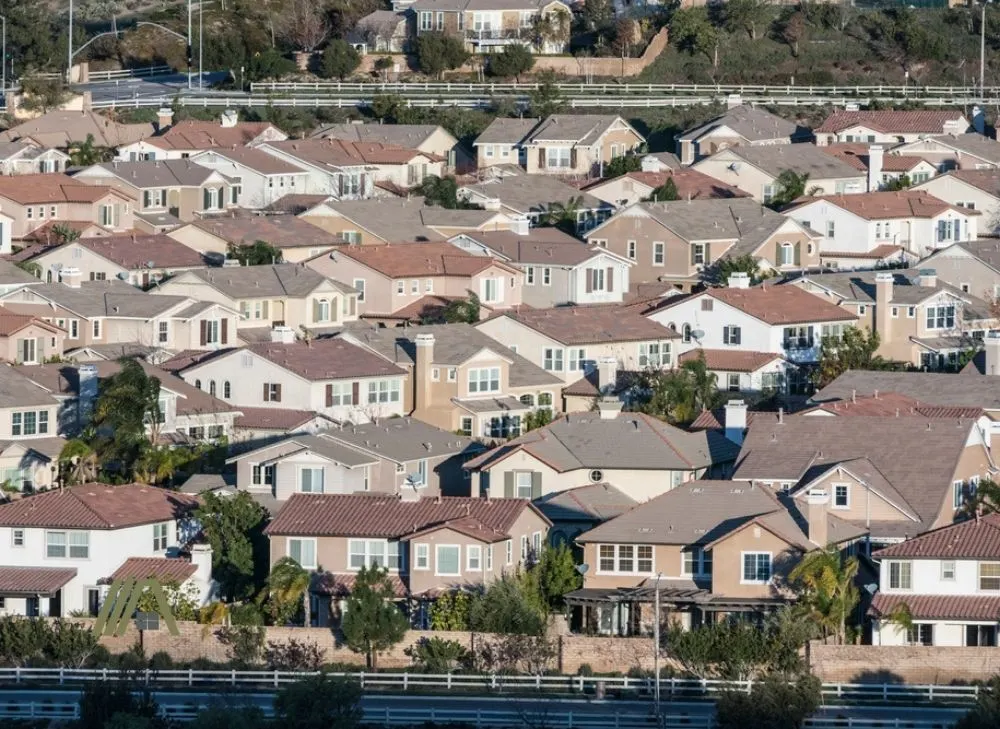You have probably passed through a neighborhood and realized that you are seeing the same house over and over, with only a slight color or decorative difference. This is not some Pleasantville scenario, but it is instead the result of trends and the urgent need for housing.
The clone-like style of a neighborhood is the result of tract housing. This is large-scale development, where developers purchase an area and attempt to build quality housing in the quickest and cheapest way. Part of that is not to personalize every house according to housing trends, but rather stick with one applicable model.

Seemingly identical suburban houses are the result of large-scale development projects. It’s more cost-effective for developers to create and build a single design, which allows them to cater to housing demands. This standardization is why houses seem to look the same.
Few Houses Are Built By Individuals
If every house in the suburbs were built by its future owner, the houses would look different. In the past, this is how it primarily happened. You didn’t buy a house; you bought land and had a house built. This is why older neighborhoods have more variety when it comes to the appearance and design of the houses.
However, the vast majority of houses these days are built by housing development companies. This has several implications (discussed in later sections), the result of which are houses that look the same. There’s even a name for it: tract housing or cookie-cutter housing.
The History
Tract housing became popular in the 1940s and onwards, following World War II. There were a lot of social and economic changes associated with this post-war period, and it resulted in a building boom.

There was a sudden, high demand for housing. The fastest way to cater to this demand required the construction companies to find the quickest way to build housing. Not only that, but they needed to make sure the housing was affordable for the economic group they were attempting to supply.
By standardizing housing design and the materials needed, developers could churn out the houses faster than using unique designs and materials for each individual residence.
Limited Design Input
When a housing development company buys a tract of land (hence the name tract housing), they will hire someone to design the houses that will be built there. The design will be limited in terms of input because you won’t have a different architect per house. In some cases, there will be just one person who designs the houses.
This does not mean that the person is only capable of designing one type of house. It simply means that even if they designed each house differently, there would be a significant number of similarities because of that person’s way of thinking and how they were trained.
There is also a difference in perspective. We drive through the neighborhood and see the same house one after the other. However, the design was developed for a large-scale model. So, while we see individual housing, the developers and designers see the tract as one big related project. Put like this, it makes sense that they all match.
Creativity Is Low on the Priority List
Even if you had a whole team of designers or even just a few with wild imaginations, their creative input would have to be limited to what would be most widely appealing to buyers.
You can design an artistically beautiful house that 5 people would pay absolute fortunes for, but if you have 20 of those houses, then 15 will struggle to sell.
Instead, the housing developers look at who would buy in the area and what would appeal most to this population. Once they find a suitable design to meet the criteria of their target population, there wouldn’t be many benefits to deviating from that model.
Additionally, it is easier for the individual buyers to modify and adjust the house instead of the developers wasting time and resources on something the buyer may not prefer. In essence, you can look at cookie-cutter houses as a blank canvas.
Cookie-Cutter Houses Save Costs
Housing developers are not looking to break even or make a small profit. That wouldn’t be a very sustainable business practice for their company. Instead, they want as many houses as possible to be built for free.
What this means is that they want, through various “bulk-buy” kinds of deals, to build, say, 50 houses for the price of 30 or 100 houses for the price of 50. So if, for no extra cost, you can build 100 houses, why stop at 50?
Design Savings
If 100 houses are going to be built, paying for 100 different designs is going to be too expensive to be viable. Paying for one design that only needs minimal adaptations to account for any differences in orientation, ground slope, etc., will be far more financially economical.

Even including some aspects, like garages, that can be included/excluded, or giving the option of 2-bedrooms or 3-bedrooms, will not cost nearly as much as individual designs. In this way, there is the illusion of difference and choice for the buyer and adaptability for different needs, but without interfering with the developer’s profit margin.
Material Savings
We all know the benefits of bulk buying, and the construction industry is no different. If you buy more than 10 crates of X, you can get 2 free or you can get a discount on them all. These kinds of deals are appealing to companies in the process of building multiple houses at once.
So, if the houses are all designed the same, then there are many more bulk-buy opportunities, which further saves money.
I can imagine it also makes it easier to deal with a faulty product if you have extras in stock instead of needing to make an individual order and payment.
Fixtures and Finishes Savings
In the same way that tract houses result in cheaper materials, it also means better pricing on fixtures and finishes like paint, door handles, and even yards. So, even if there are a couple of different design options for these, there will still be opportunities for bulk buying and saving money.
Now, I don’t want you to think that housing developers are just focused on money. While this is important, most companies are still after customer satisfaction. After all, this is how a good reputation is built.
If they can save money on actually purchasing the fixtures and finishes, then they may be able to opt for those of better quality, making your home look as nice as possible, even if it does look like all the other houses on the block.
Building the Houses Takes Less Time
Houses Designed to Be Built Quickly
The high demand for housing means that it is more efficient to create a single house design and repeat that with each home. The housing needs to be done as fast as possible to cater to the demand and to create the most profit.
Many people think houses in California lack basements because of the earthquakes, but one of the main reasons was that they were building many houses at once and it was quicker without a basement. The demand for housing for such a large population has also resulted in Californian houses being quite small.

The fastest way to build multiple houses is if they are the same house in different locations with as few changes as possible.
Builders Learn What to Do
The more similar the houses are, the easier it is for the builders. Standardized design minimizes questions and uncertainty as what goes for one, applies to all.
After the first few houses, certain elements of the build will become second nature to the people actually building the houses.
For example, they won’t have to check how tall a wall must be; they will remember from the last one. They won’t have to figure out how to make X work because they solved that problem on house 1. And so on.
These houses are also built one after the other or a few at a time. Either way, there is very little time in between builds during which people can forget things, especially when they are repeating the same tasks and patterns over and over.
Houses Look Different Between Suburbs
Even though the houses in one neighborhood all look the same, they can differ greatly from all the identical houses in a neighboring suburb.
This is because neighborhoods are built to suit the requirements and fancies of the majority of the population. These requirements and fancies can change over the years, and thus, the design and style of housing change with those trends.
So, if you have two neighborhoods built 10 years apart, the cookie-cutter houses in one will look different from those in the other.

Savas
Monday 26th of February 2024
Thank you for explaining the history of home building in the US. When I saw it the first time I thought I came to the Soviet Union.
What I still don't understand is how people go to Starbucks and order a customized coffee with 56 ingredients but when it comes to housing they don't mind paying a million and living in a cookie cutter house as if all architects had been murdered and their profession eliminated It's so bad that if you forget your house number you won't find your house again